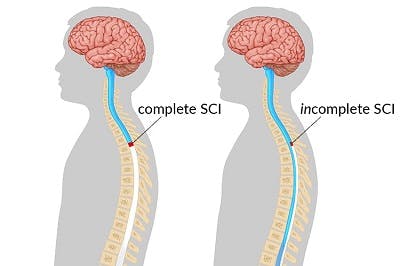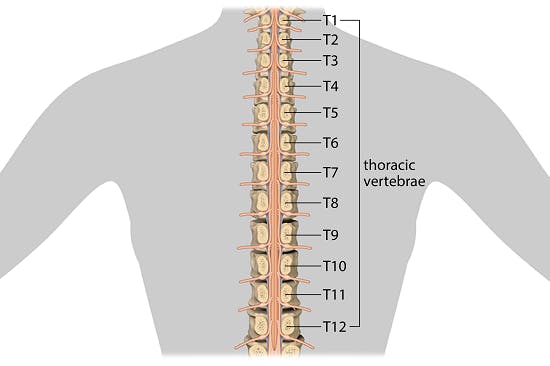Every spinal cord injury and recovery process is unique. This means that it can be hard to spot the signs of recovery from spinal cord injury since every person’s journey is different.
Factors like medical history, type of spinal cord injury, level of injury, age, and overall health contribute to recovery speed. With so many factors at play, you could be recovering and not even notice it.
To help you celebrate even the smallest signs of recovery from spinal cord injury, we’ve gathered some important milestones in this article. If you want to take it the extra mile, we highly recommend keeping a recovery journal. Having a log of your progress can help you notice changes that you may otherwise overlook.
Also, it’s important to keep an eye on both physical and psychological signs of recovery, because they are equally important. This article will discuss both.
What to Know Before You Look for Signs of Recovery from Spinal Cord Injury
The spinal cord plays an essential role in movement and sensation throughout the body. When the spinal cord sustains damage, it can impair movement and sensation from the point of injury down. For example, someone that injures their low-back (a lumbar spinal cord injury) can potentially experience impaired movement or sensation from the low-back and down.
The rehabilitation process focuses on improving as much movement and sensation as possible. But before we dig into the signs of recovery from SCI, it’s important to outline the difference between an incomplete and complete spinal cord injury.

With an incomplete SCI, the spinal cord has sustained damage but there is still connection at the site of injury. Individuals with incomplete SCIs may have impaired movement or sensation below the level of injury, but it’s not fully impaired.
With a complete SCI, the spinal cord has been fully severed and no connection exists between the upper and lower spinal cord at the site of injury. Individuals with complete SCIs have no movement or sensation below the level of injury, resulting in paraplegia (paralysis of the lower limbs) or quadriplegia (paralysis of all four limbs).
Generally speaking, the recovery outlook for an incomplete SCI is more optimistic than a complete SCI. When some connections exist, the spinal cord is capable of utilizing neuroplasticity to strengthen existing pathways and create new ones. Therefore, it’s important to ask your doctor for information about the completeness of your SCI.
How Spinal Shock Can Cover Up Signs of Recovery
Be aware, though, that sometimes an incomplete SCI is confused or even misdiagnosed as a complete SCI due to spinal shock.
Immediately after a spinal cord injury, your spinal cord may enter spinal shock where the body attempts to heal itself by activating an inflammation response. Spinal shock causes a temporary loss of sensory or motor functions below your level of injury, which resembles the symptoms of a complete SCI.
Spinal shock can persist for days to weeks, but typically resolves around 4-6 weeks. After spinal shock subsides, functions may gradually start to return and at this point you’ll have a better idea of what functions are or are not affected by your SCI.
Therefore, if you’re looking for signs of recovery from spinal cord injury, it’s helpful to understand spinal shock, because symptoms may improve on their own as inflammation goes down.
Physical Signs of Recovery from Spinal Cord Injury
Now that you understand how SCI recovery is influenced by the completeness of the injury and spinal shock (during the early stages) let’s discuss some physical signs of recovery from spinal cord injury.
Keep in mind that every SCI is different, and every survivor will experience different signs of recovery. These are not hard rules. Instead, these are general patterns that can provide a loose signal of progress.
An improvement in any single one of these symptoms is a sign of physical recovery from spinal cord injury:
Pain Below the Level of Injury
Surprisingly, pain after spinal cord injury could actually be a sign of recovery.
In order to feel pain, sensory signals below the level of injury must reach the brain. This indicates that the spinal cord injury is incomplete, not complete; and the prognosis for an incomplete SCI is generally more optimistic.
Almost 80% of all survivors experience pain after spinal cord injury; and while this is a sign of recovery, it can impact your quality of life. If you experience pain after SCI, discuss your options with your doctor. Certain meditations, or in some cases therapy, may provide relief.
Spasticity Below the Level of Injury
Spasticity is another surprising sign of recovery from spinal cord injury.
Spasticity causes involuntary muscle contractions due to disrupted signals between the brain and areas below the level of injury. Spasticity is “velocity-dependent,” which means that the quicker a muscle is stretched, the more severely it will contract.
While spasticity and muscle stiffness are conditions that require rehabilitation in order to improve, they are a sign of recovery; because motor signals must be able to pass through the spinal cord in order for muscles to contract at all.
In fact, during spinal shock, muscles become flaccid and not only become paralyzed but also lose tone (i.e. become “floppy”). Flaccid paralysis is a symptom of a complete SCI because no motor signals are able to reach muscles below the level of injury.
Use the presence of spasticity as motivation to keep stretching and practicing spinal cord injury rehab exercises to help improve motor function.
Tingling Below the Level of Injury
Mild tingling after spinal cord injury can also be a sign of recovery. It means that sensory signals below the level of injury are able to reach the brain, once more indicating an incomplete SCI instead of a complete SCI.
While tingling can be a concern, it’s a stronger sign of recovery than altogether loss of feeling and sensation. Even though sensation might be affected, the presence of altered sensation provides hope that sensory function can improve, especially when rehabilitation is pursued. Talk to your therapist about methods to address tingling after SCI, such as electrical stimulation or sensory reeducation.
How to Measure Physical Recovery After Spinal Cord Injury
There are several ways to measure progress after spinal cord injury. However, use caution when doing so. Fixating on numbers and physical recovery can be disheartening because the little milestones between the bigger milestones may go overlooked.
It can be helpful to understand how clinicians measure SCI recovery, but it should not become the end-all-be-all for your recovery goals.
ASIA Impairment Scale
If you’re eager for a way to measure progress, take a look at the ASIA Impairment Scale (AIS). There are five categories, where level A refers to no motor or sensory function below the level of injury and level E refers to full functional recovery.
Spinal cord injury survivors that pursue rigorous rehabilitation can often “jump up” one level on the ASIA Impairment Scale. For example, a survivor with a consistent home therapy program may “jump” from AIS B (sensory function remains, but no motor function exists) to AIS C (more than half the muscles below the level of injury have function).
Often, it takes months or even years of consistent rehabilitation to move up on the ASIA Impairment Scale. This is why it’s more motivating to focus on small milestones than just the bigger ones.
Your Level of Injury

Many spinal cord injury survivors recover at least a couple levels of muscle movement, which means symptoms may improve from the current level of injury to the next higher level of injury. For example, you can recover a T4 injury to a T5 injury, which presents with less impaired functions.
Although this may seem like you’re “only” improving one level of injury, it’s actually an incredible sign of progress. If you continue to pursue therapy both with your therapist and at home, that T5 injury may improve to a T6 injury and so on.
Again, sometimes you don’t even notice the signs of recovery from spinal cord injury because the bigger milestones, such as walking again, pull your focus from the little signs of recovery right in front of you.
For this reason, be sure to keep a recovery journal and participate in a home therapy program that automatically tracks your progress, such as FitMi home therapy.
Psychological Signs of Recovery from Spinal Cord Injury
Many survivors and family members focus only on the physical signs of recovery but the psychological side should not be overlooked. Psychological wellness can promote further physical improvement, so it’s important not to prioritize one over the other. Psychological care is essential after spinal cord injury.
Here are some psychological signs of recovery after SCI:
Seeking Therapy or Counseling
A spinal cord injury presents many challenges and unwanted lifestyle changes, such as using a wheelchair or changing careers. This is one of many causes for depression after SCI.
Poor psychological health can impede motivation to pursue physical recovery, which can lead to a downward spiral. Survivors should not feel shame in seeking psychological help, such as psychotherapy or counseling. In fact, it could be a sign of recovery, because it means you’re ready to take action to improve how you feel about your situation.
Furthermore, a survey found that 86% of people with quadriplegia (paralysis from the neck down) rated their quality of life as average or better than average. It can take time to reach this level of acceptance, but it’s something that many survivors have done and you probably will too, with the right action.
Setting Small and Big Goals
When you only set big goals, you leave a lot of time in between to get discouraged. Therefore, it’s important to step away from an all-or-nothing mindset and set both big and small goals. Not only does this help with motivation, but it helps you see all the signs of recovery that happen along the way.
Staying Cautiously Curious About Your Doctor’s Prognosis
You should always listen to your doctors and therapists, especially when it comes to medical advice, exercises, and guidance. With that said, it can also help your recovery to stay curious about any limitations declared.
For example, if you have an incomplete SCI but your doctor says that you’ll never be able to walk again — but thanks to diligent research you know that an incomplete injury generally offers more hope for recovery — you can kindly remain curious about what you can accomplish and keep pursuing rehab.
Studies have found that anywhere from 20% to 75% of individuals with an incomplete SCI will recover some degree of walking capacity by 1 year post-injury. Neither you nor your doctor know with certainty whether or not you will be part of that percentage. The only thing you can do is stay curious, be diligent, and keep pursuing rehabilitation.
Tracking Your Unique Signs of Recovery from SCI
Physical and psychological signs of recovery from spinal cord injury build off one another and are equally important. You can promote your best recovery by pursuing both a rigorous home exercise program and also tending to your psychological wellbeing.
Also, talk to your therapist about the AIS Impairment Scale and keep a record of your progress in a recovery journal. While it can take many months or even years to “jump” up a level, many small milestones occur in between, and they deserve to be celebrated.
The post Signs of Recovery from Spinal Cord Injury: What to Look for & Why It Matters appeared first on Flint Rehab.



